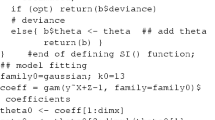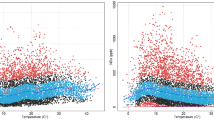Abstract
The single-index model is an important tool in multivariate nonparametric regression. This paper deals with M-estimators for the single-index model. Unlike the existing M-estimator for the single-index model, the unknown link function is approximated by B-spline and M-estimators for the parameter and the nonparametric component are obtained in one step. The proposed M-estimator of unknown function is shown to attain the convergence rate as that of the optimal global rate of convergence of estimators for nonparametric regression according to Stone (Ann Stat 8:1348–1360, 1980; Ann Stat 10:1040–1053, 1982), and the M-estimator of parameter is \(\sqrt{n}\)-consistent and asymptotically normal. A small sample simulation study showed that the M-estimators proposed in this paper are robust. An application to real data illustrates the estimator’s usefulness.

Similar content being viewed by others
References
Carroll RJ, Fan J, Gijbels I, Wand MP (1997) Generalized partially linear single-index models. J Am Stat Assoc 92:477–489
Cheng G, Huang JZ (2010) Bootstrap consistency for general semiparametric M-estimation. Ann Stat 38:2884–2915
Cox DD (1983) Asymptotics for M-type smoothing splines. Ann Stat 11:530–551
Delecroix M, Hristache M, Patilea V (2006) On semiparametric M-estimation in single-index regression. J Stat Plan Infer 136:730–769
Eggleston HG (1958) Convexity, Cambridge tracts in mathematics and mathematical physics, vol 47. Cambridge University Press, Cambridge
Elmi A, Ratcliffe SJ, Parrey S, Guo WS (2011) A B-spline based semiparametric nonlinear mixed effects model. J Comput Graph Stat 20:492–509
Fan J, Hu T, Truong Y (1994) Robust nonparametric function estimation. Scand J Stat 21:433–446
Gao J, Liang H (1997) Statistical inference in single-index and partially nonlinear models. Ann Inst Stat Math 49:493–517
Hample FR, Ronchetti EM, Rousseeuw PJ, Stahel WA (1986) Robust ststistics. The approach based on influence functions. Wiley, New York
Härdle W, Stoker TM (1989) Investing smooth multiple regression by the method of average derivatives. J Am Stat Assoc 84:986–995
Härdle W, Hall P, Ichimura H (1993) Optimal smoothing in single-index models. Ann Stat 21:157–178
He X, Shi P (1994) Convergence rate of B-spline estimators of nonparametric conditional quantile functions. J Nonparametric Stat 3:299–308
He X, Shi P (1996) Bivariate tensor—product B-spline in a partly linear model. J Multivar Anal 58:162–181
He X, Zhu ZY, Fung WK (2002) Estimationin a semiparametric model for longitudinal data with unspecidied dependence structure. Biometrika 89:579–590
He X, Fung WK, Zhu ZY (2005) Robust estimation in genearlized partial linear models for clusters data. J Am Stat Assoc 100:1176–1184
Hristache M, Juditsky A, Spokoiny V (2001) Direct estimation of the index coefficient in a single-index model. Ann Stat 29:595–623
Huang JZ (2003) Local asymptotic for polynomial spline regression. Ann Stat 31:1600–1635
Huang JZ, Liu L (2006) Polynomial spline estimation and inference of proportional hazards regression models with flexible relative risk form. Biometric 62:793–802
Huang J, Wu C, Zhou L (2002) Varying-coefficient models and basis function approximations for the analysis of repeated measurements. Biometrika 89:111–128
Huber PJ (1964) Robust estimation of location parameter. Ann Math Stat 35:73–101
Huber PJ (1981) Robust statistics. Wiley, New York
Ichimura H (1993) Semiparametric least square (SLS) and weighted SLS estimation of single-index models. J Econom 58:71–120
Jiang CR, Wang JL (2011) Functional single index models for longitudinal data. Ann Stat 39:362–388
Kozek AS (2003) On M-estimators and normal quantiles. Ann Stat 31:1170–1185
Li JB, Zhang RQ (2011) Partially varying coefficient single-index proportional hazards regression models. Comput Stat Data Anal 55:389–400
Liang H, Liu X, Li RZ, Tsai CL (2010) Estimation and testing for partially linear single-index model. Ann Stat 38:3811–3836
Lin X, Wang N, Welsh AH, Carroll RJ (2004) Equivalent kernel of smoothing splines in nonparametric regression for clustered/longitudinal data. Biometrika 91:177–193
Naik P, Tsai CL (2000) Partial least squares estimator for single-index. J R Stat Soc Ser B 62:763–771
Powell JL, Stoker JH, Stoker TM (1989) SAemiparametric estimation of index coefficients. Econometrica 57:1403–1430
Rice J (1986) Convergence rates for partially splined models. Stat Probab Lett 4:203–208
Schumaker LL (1981) Spline functions. Wiley, New York
Shi P, Li G (1995) Optimal global rates of convergence of B-spline M-estimators for nonparametric regression. Stat Sinica 5:303–318
Silverman BW (1984) Spline smoothing: the equivalent variable kernel method. Ann Stat 12:898–916
Speckman P (1988) Kernel smoothing in partial linear models. J R Stat Soc Ser B 50:413–436
Stoker TM (1986) Consistent estimation of scaled coefficients. Econometrica 54:1461–1481
Stone C (1980) Optimal rates of convergence for nonparametric estimators. Ann Stat 8:1348–1360
Stone C (1982) Optimal global rates of convergence for nonparametric regression. Ann Stat 10:1040–1053
Wang N (2003) Margnial nonparametric kernel regression accounting for within-subject correlation. Biometrika 90:43–52
Wang L, Yang LJ (2009) Spline estimation of single-index models. Stat Sinica 19:765–783
Welsh AH (1996) Robust estimation of smooth regression and spread functions and theirs derivates. Stat Sinica 6:347–366
Welsh AH, Lin X, Carroll RJ (2002) Marginal nonpartametric regression: locality and efficiency of spline and kernel methods. J Am Stat Assoc 97:482–493
Wu WB (2007) M-estimation of linear models with dependent errors. Ann Stat 35:495–521
Wu TZ, Yu KM, Yu Y (2010) Single-index quantile regression. J Multi Anal 101:1607–1621
Xia YC, Härdle W (2006) Semi-parametric estimation of partially linear single-index models. J Multi Anal 97:1162–1184
Xia YC, Tong H, Li WK, Zhu LX (2002) An adaptive estimation of dimension reduction space. J R Stat Soc Ser B 64:363–410
Yu Y, Ruppert D (2002) Penalized spline estimation for partially linear single-index models. J Am Stat Assoc 97:1042–1054
Author information
Authors and Affiliations
Corresponding author
Appendix
Appendix
In this section, we prove the results of Theorems 1 and 2. Let
\(H_n^2=NZ_n^\tau Z_n,\quad z_i=H_n^{-1}B(x_i^\tau \beta _0), \lambda _n\) is the smallest eigenvalue of \(N/nH_n^2\).
Lemma 6.1
If the Assumption 1–2 is satisfied, then
where \(I\) is an identity matrix.
Proof
The proof of this Lemma 6.1 is referred to Gao and Liang (1997). \(\square \)
Lemma 6.2
Under Assumption 1, there exists a constant \(c\) such that
where \(k_n\) is the number of knots in the same order of \(N\).
This Lemma justifies the approximation power of B-spline. Its proof follows readily from Corollary 6.21 in Schumaker (1981) .
Lemma 6.3
Assume \(lim_{n\rightarrow \infty } n^{\gamma -1}k_n^2=0\) for some \(\gamma \ge 0\), then with probability one
A complete proof can be found in Shi and Li (1995).
Proof of Theorem 1
By Lemma 6.2, there exists a constant \(M\) such that
Thus,
Then, in order to prove (2.5) hold, it suffices to show that
Denote \(V^*(\theta _0)=(I-P)V(\theta _0)= (v_1^*(\theta _0),\ldots ,v_n^*(\theta _0))^\tau , S_n=V^*(\theta _0)^\tau V^*(\theta _0)\).
Let
In order to attain (6.7), we first show that \(||\hat{\theta }||=O_p(k_n^{1/2})\). Let \(\tilde{v_i}(\theta _0)=S_n^{-\frac{1}{2}}v_i^*(\theta _0), \tilde{B}(x_i^\tau \beta _0)=H_n^{-1}B(x_i^\tau \beta _0)N^{1/2}\).
Then, we have that
which is minimized at \(\hat{\theta }\), where \(R^*(\theta )=B^{\prime }(\beta _0^\tau x_i)^\tau \delta _0 x_i^\tau S_n^{-1/2}\theta _1-B^{\prime }(x_i^\tau \beta ^*)^\tau \delta x_i^\tau \) \( S_n^{-1/2}\theta _1, \beta ^*\) is between \(\beta \) and \(\beta _0\).
According to the properties of B-spline, there exist constant vectors \(s_j j=1, \ldots , N\), for any \(h_j(x_i^\tau \beta _0)\),
where \(\tilde{R}_{nij}\) is the remainder of \(h_j(x_i^\tau \beta _0)\) approximating by B-spline. According to Lemma 6.2, \(g^{\prime }(x_i^\tau \beta _0)x_i=B^{\prime }(x_i^\tau \beta _0)^\tau \delta _0 x_i+\tilde{R}_{ni}, \sup _{1\le ni}|\tilde{R}_{ni}|\le k_n^{-(r-1)}\) by Assumption 3, we know that there exist matrices \(G\) and \(W_n\) such that
where \(W_n=\tilde{R}_n+U_n, \tilde{R}_n=(\tilde{R}_{nij})_{n\times N}, U_n=(u_{ij})_{n\times N}, G=(s_1,\ldots ,s_N)\). Hence, any column of \(V^*(\theta _0)\) is of the order of \(O_p(n^{1/2})\),
Therefore, according to (6.8), Lemmas 6.1, 6.2 and 6.3
Thus, when \(|\theta |\le L, \delta =\delta _0+O_p(Nn^{-1/2})\). Because the derivative of \(g(\cdot )\) is continuous and bounded, by Lemma 6.2, have
As the support of \(X\) is convex, so when \(|\theta |\le L\)
Therefore
According to Assumption 4–5, by similar argument to those for the below Lemma 6.4 of this paper, we have for any \(L>0\), that
Note that \(|k_n^{-1/2}\sum _{i=1}^n\tilde{v_i}(\theta _0)R_{ni}b| =||k_n^{-1/2}S_n^{-\frac{1}{2}}(W_n^\tau (I-P)+G^\tau Z_n^\tau (I-P))r_n||=o_p(1),\) where \(r_n\) is a vector formed by \(R_{ni}b\) and \(R^*(\theta )=O_p(n^{-1/2})=o_p(R_{ni})\) for any \(L>0\).
By Assumption 4–5 and the fact \(\sum _{i=1}^n\tilde{v_i} (\theta _0)\tilde{B}(x_i^\tau \beta _0)^\tau =0\), we have
By the Tchebychev inequality and Assumption 4, we obtain
Hence, \(\sup _{||\theta ||=L} k_n^{-1/2}|\sum _{i=1}^n \tilde{v_i}(\theta _0)^\tau \theta _1\psi (e_i)|=O_p(L)\).
Similarly, \(\sup _{||\theta ||=L} k_n^{-1/2}|\sum _{i=1}^n \tilde{B}(x_i^\tau \beta _0)^\tau \theta _2\psi (e_i)|=O_p(L)\).
Thus, it follows from (6.13) that, for sufficiently large \(L\),
with probability tending to 1 as \(n\rightarrow \infty \). Combining (6.12) and (6.14) yields
which implies,by the convexity of \(\rho \), that
We then conclude that \(||\hat{\theta }||=O_p(k_n^{1/2})\). By (6.8), we have
Thus
Hence,
As the derivative of \(g(\cdot )\) is bounded and the support of \(X\) is compact, so
The proof of Theorem 1 is completed.
To obtain asymptotic normality of \(\hat{\beta }_0\), we shall make use of several asymptotic linearization results which are similar to Lemmas 6.3 and 6.4 of He and Shi (1996). The proofs is similar to the argument in He and Shi (1996).
Lemma 6.4
Under the Assumption of Theorem 2, we have for any \(L>0\) and \(M_0>0\)
where \(E_e\) is the expectation with respect to \(e\).
Proof
Because \(f_e(\cdot )\) is continuous at 0, there exist two positive numbers \(\omega _1,\omega _2\) such that when \(|t|\le \omega _2\), \(|f_e(t)|<\omega _1\) holds. By (6.13), (6.14) and Lemma 6.2, have
In order to prove the (6.19), it suffices to show that given \(\varepsilon >0\),
Denote \(\Gamma =\{\theta _1:|\theta _1|\le 1, \theta _1\in R^{p}\}\) as a union of \(K_n\) disjoint parts \(\Gamma _1,\ldots ,\Gamma _{k_n}\) such that the diameter of each part does not exceed \(q_0=k_n\varepsilon /(8b_2M\omega _2n)\). Then \(K_n\le (2\sqrt{p}/q_0+1)^p\). Choose \(\theta _{1j}\in \Gamma _j\), for each of \(j=1,\ldots , K_n\), by Assumptions 5–6 and Lemma 6.3, we have
where \(I(\cdot )\) is a indicator function. According to Assumption 6 and the mean theorem of differential, have
It follows the Assumption 6 again that,
Therefore, given \(X^{*}=(X_1,\ldots ,X_n)\), by (6.23), we have
By (6.21), (6.22), (6.23), (6.24) and Bernstein inequality, given any \(\varepsilon >0\), we have
where \(\gamma =\varepsilon ^2/8b_2^2M^2\omega _1\omega _2\). As \(k_n=n^{1/(2r+1)}\), so (6.19) holds. The Lemma 6.4 is shown. \(\square \)
Lemma 6.5
If Assumptions of Theorem 2 hold, then
where \(\sup _{|\theta _1|\le M_0,|\theta _2\le Lk_n^{1/2}}|r(\theta _1,\theta _2)|=o_p(1)\).
The proof of Lemma 6.5 is similar to those of (6.16), so the proof is omitted.
Proof of Theorem 2
Let \(\hat{\theta }^\tau =(\hat{\theta }_1^\tau , \hat{\theta }_2^\tau )\) as \(\hat{\theta }\) in the proof of Theorem 1, and \(\tilde{\theta _1}=b^{-1}\sum _{i=1}^n\tilde{v_i}(\theta _0)\psi (e_i)\). Following Lemmas 6.4, 6.5 and triangle inequality, for any \(L>0\) and \(\varepsilon >0\), we obtain
Notice that when \(L\rightarrow \infty , P\{|\tilde{\theta }_1|\le L\}\rightarrow 1, P\{|\hat{\theta }_2|\le Lk_n^{1/2}\}\rightarrow 1\) hold. Then
Therefore, when \(|\theta _1-\tilde{\theta }_1|=\varepsilon ,\theta _1\in R^p\), we obtain
It follows from the above formula that
According to Corollary 25 of Eggleston (1958), we have
By the definition of \(\hat{\theta }\), we obtain
According to Lemma 6.1, the central limit theorem and Slutsky’s theorem, we have
Rights and permissions
About this article
Cite this article
Zou, Q., Zhu, Z. M-estimators for single-index model using B-spline. Metrika 77, 225–246 (2014). https://doi.org/10.1007/s00184-013-0434-z
Received:
Published:
Issue Date:
DOI: https://doi.org/10.1007/s00184-013-0434-z




